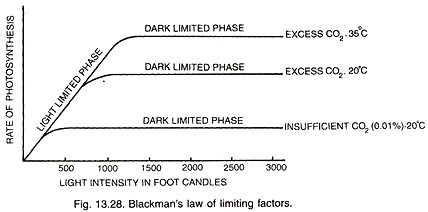ADVERTISEMENTS:
In this article we will discuss about the Principle or Law of Limiting Factors.
Optimum value of a factor is never constant. It depends upon the magnitude of other factors. We may continue to increase the magnitude of one or more factors without influencing the rate of reaction.
In such cases it is found that a factor called limiting factor is holding the balance. A limiting factor is defined as a factor which is deficient to such an extent that increase in its magnitude directly increases the rate of the process.
ADVERTISEMENTS:
The effect of limiting factors was studied by Blackman in 1905. He formulated the principle of limiting factors which states that when a process is conditioned as to its rapidity by a number of separate factors, the rate of the process is limited by the pace of the slowest factor. In other words the rate of a physiological process is limited at a given time by one and only one factor which is deficient.
Blackman (1905) studied the effect of CO2 concentration, light intensity and temperature on rate of photosynthesis. All other factors were maintained in optimum concentration. Initially the photosynthetic material was kept at 20°C in an environment having 0.01% CO2.
When no light was provided to photosynthetic material, it did not perform photosynthesis. Instead, it evolved CO2 and absorbed O2 from its environment. Blackman provided light of low intensity (say 150 foot candles) and found photosynthesis to occur.
When light intensity was increased (say 800 foot candles), the rate of photosynthesis increased initially but soon it levelled off. The rate of photosynthesis could be further enhanced only on the increase in availability of CO2. Thus, initially light intensity was limiting the rate of photosynthesis. When the same was available in sufficiency, CO2 became limiting (Fig. 13.28).
When both were provided in sufficient quantity, the rate of photosynthesis rose initially but again reached a peak. It could not be increased further.
At this time, it was found that increase in temperature could raise the rate of photosynthesis up to 35°C. Further increase was not possible. At this stage, sme other factor became limiting. Therefore, at one time only one factor limits the rate of a physiological process.
Objections:
(i) Blackman postulated that change over from one limiting factor to another is abrupt. Actually transitional curves are present in such regions.
During transition, a change in either of the two factors may change the rate of the process. The transitional curves are produced because of the presence of a large number of green cells and numerous chloroplasts in these cells. Some must be receiving more light than others while a few must be getting more CO2.
(ii) The rate of a process cannot be increased indefinitely by increasing the availability of all the known factors,
(iii) The principle is not operative for toxic chemicals or inhibitors, (iv) It is believed by some authors that a reaction can be limited simultaneously by two or more factors.
